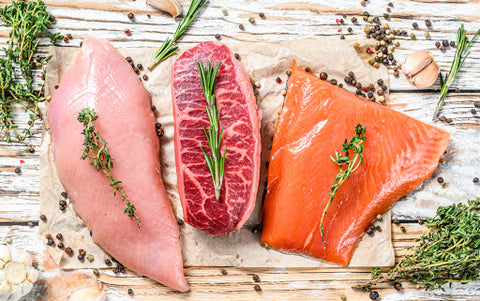We spent more than 18 months developing Beta Red. Our goal, as always, was to develop nutrition to help you perform better and reach your goals. This week, we're exploring the three key amino acids present in Beta Red that help improve athletic performance. The three amino acids we'll focus on are Beta Alanine, Citrulline Malate, and Betaine. In this first segment, we'll cover Beta Alanine.
Fair warning: we’re about to get a little scientific. Beta-alanine is a naturally-occurring, non-essential amino acid. In the body, it and another amino acid, histidine, are combined to form carnosine, a dipeptide found in muscle and brain cells. Carnosine has antioxidant-like effects on certain proteins, and can help prevent toxic protein waste buildup in the body, increasing performance of each cell. Because of its role in keeping cells healthy, carnosine has been linked with longevity and aging.

A Beta Alaine molecule
One of carnosine’s primary interests to researchers and athletes alike is as an intracellular buffer. It decreases acidity by removing hydrogen ions generated during intense physical activity. This pH regulation allows muscles to function better under intense workloads.
Since we’re talking about carnosine, why not include it, instead of beta-alanine, in Beta Red? Much of the carnosine you consume in foods is actually broken down into beta-alanine and histadine during digestion, which means these amino acids then need to be converted back into carnosine in muscle tissue. Because of this, it’s more efficient to consume beta-alanine to increase muscle carnosine concentration.
Is beta-alanine found in normal food? Yes! Meats, poultry and some beans are the main dietary sources of beta-alanine, although the quantity is far less than in a serving of Beta Red. Fun fact: the more metabolic activity that animal had during it’s life, the higher levels you will find of both beta-alanine and carnosine (so free ranging meat sources will be more beneficial). That’s great news for meat eaters, but carnosine levels tend to be lower in vegetarians — which makes Beta Red even more powerful if you’re sticking to a plant-based diet.

Let’s tie this back to our super juice (Beta Red) and performance. Due to its previously mentioned effects, consuming beta-alanine can improve performance of repeated high-intensity efforts of 60-240 seconds. These efforts can be in the form of weight training, stand-alone sprints, or accelerations and/or short climbs during a longer endurance workout or race. Some research shows that it also reduces the perception of fatigue during exercise near exhaustion, giving you that last little kick to cross the line first.
While you’ll experience benefits from your first serving of Beta Red, regular use will lead to increased muscle carnosine concentration due to its beta-alanine content, and this can last in excess of 8 weeks after you’ve stopped drinking it.

Beta-alanine is responsible for the slight tingling you might notice when you sip Beta Red before your race or workout. This effect can be lessened by consuming a carbohydrate-rich food while drinking Beta Red. Research indicates this carbohydrate / beta-alanine combination may also yield better results than beta-alanine alone, so don’t hesitate blending Beta Red in your pre-workout smoothies or eating a carbohydrate-rich snack while drinking it.
The bottom line if you are an endurance athlete is that Beta Red Performance Formula will allow you to get more out of your training and perform better.

Leave a comment